

2024 Prize Winners
Dr. Daniel Mazzone from the Paul Scherrer Institut (PSI) in Villigen, Switzerland has been awarded with the Erwin Félix Lewy Bertaut Prize.
He has been awarded this price due to his outstanding contributions in field of quantum effects in strongly correlated electron materials, employing cutting-edge X-ray and neutron scattering techniques.
Further details are found here.
2023 Prize Winners
1-Walter Hälg Prize Winner: Prof. Toby Perring
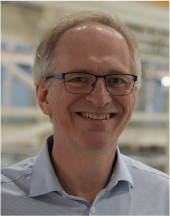
Prof. Toby Perring is awarded the 2023 ENSA Walter Hälg Prize, sponsored by SwissNeutronics, for his exceptional contributions to neutron science through his work on time-of-flight single crystal spectroscopy.
Through several decades Prof. Toby Perring has been a central leading figure in the evolution of highly pixelated direct time-of-flight spectrometers for the investigation of excitations in strongly correlated electron systems. Toby has been instrumental in all steps in this revolution. He conceived, designed, built, commissioned and
ensured scientific success of the MAPS spectrometer at ISIS. MAPS was the first neutron time-of-flight spectrometer with a large array of position-sensitive detectors, allowing for efficient mapping of large areas in momentum and energy space. With unprecedented momentum and energy range and resolution, MAPS enabled detailed studies of excitations in strongly correlated systems to energies beyond 100 meV, particularly in pioneering experiments on the spin excitations in high-temperature superconductors. Prof. Perring’s innovative ideas behind the MAPS spectrometer motivated the construction of similar spectrometers at other international facilities.
Furthermore has Prof. Toby Perring been instrumental in the evolution of software analysis tools unlocking the potential of the unprecedented data-volumes achieved with MAPS to be fully exploited to hitherto unachievable scientific discoveries. Starting from unique tools like TOBYPLOT and TOBYFIT, Toby undertook the challenge of nucleating community wide development efforts leading to HORACE and Mantid, which have now reached a maturity such that 1st year PhD students can now analyze 4D neutron spectroscopy data – to the great advancement of new science. In his own experiments and collaborations, Prof. Toby Perring has made seminal contributions to the understanding of the dynamics of strongly correlated electron systems, including giant magnetoresistance manganites, high-temperature superconductors, and quantum magnets. His research has led to a greater
understanding of spin waves in layered magnetic systems, spinons in low-dimensional magnets, and complex spin fluctuations in cuprate and pnictide superconductors.
The European Neutron Scattering Association (ENSA) and the global international neutron community are greatful to Prof. Toby Perring for his paradigm changing contributions to single crystal neutron spectroscopy and enthusiastically congratulate him as the 2023 recipient of the Walter Hälg prize.
Prof. Perring has been a STFC Fellow at the ISIS Facility, Rutherford Appleton Laboratory, UK since 1992 and has held various positions as a research and instrument scientist at ISIS. Since 2007 he is honorary professor in physics
at London Centre for Nanotechnology, University College London, UK. The Walter Hälg prize is sponsored by Swiss Neutronics.
2-Erwin Félix Lewy Bertaut Prize Winner: Dr Matilde Saura-Múzquiz
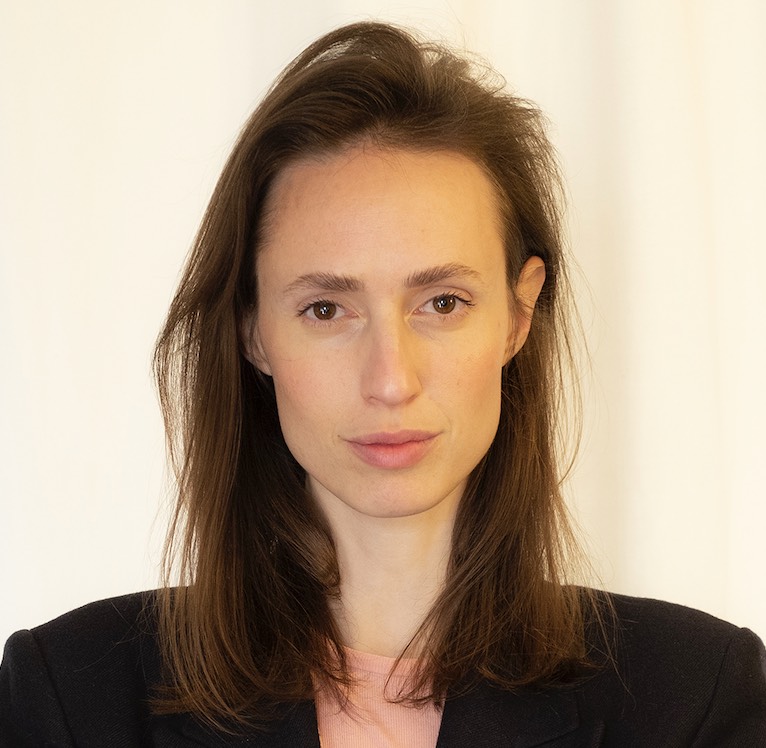
The laureate of the 2023 Erwin Félix Lewy Bertaut Prize is Dr Matilde Saura-Múzquiz, for her impressive early career contributions to the field of crystallography of functional materials, in particular those related to the studies of magnetic and non-magnetic complex oxide structures (scheelites, fergusonites, perovskites, pyrochlores, …) and studies on nanoparticle morphology, nuclear and magnetic texture and magnetic performance of sintered materials, while combining neutron and X-ray diffraction methods.
Besides her multifaceted crystallogaphic work, Dr. Saura-Múzquiz has equally contributed to patenting a new method for preparing permanent magnetic materials. Already at this early stage, Dr Matilde Saura-Múzquiz shows clearly scientific originality and independence in her research. She currently holds an individual fellowship at the University of Madrid, where she develops hew own research, on top of various supervision and undergraduate teaching activities.
The Erwin Felix Lewy Bertaut prize is awarded jointly by the European Neutron Scattering Association (ENSA) and the European Crystallography Association (ECA) in memory of the scientific achievements of Erwin Felix Lewy Bertaut, a pioneer in crystallography and neutron scattering. The prize is sponsored by Mirrotron.
3- Neutron Instrumentation and Innovation Award Winner: Dr. Alessandro Tengattini
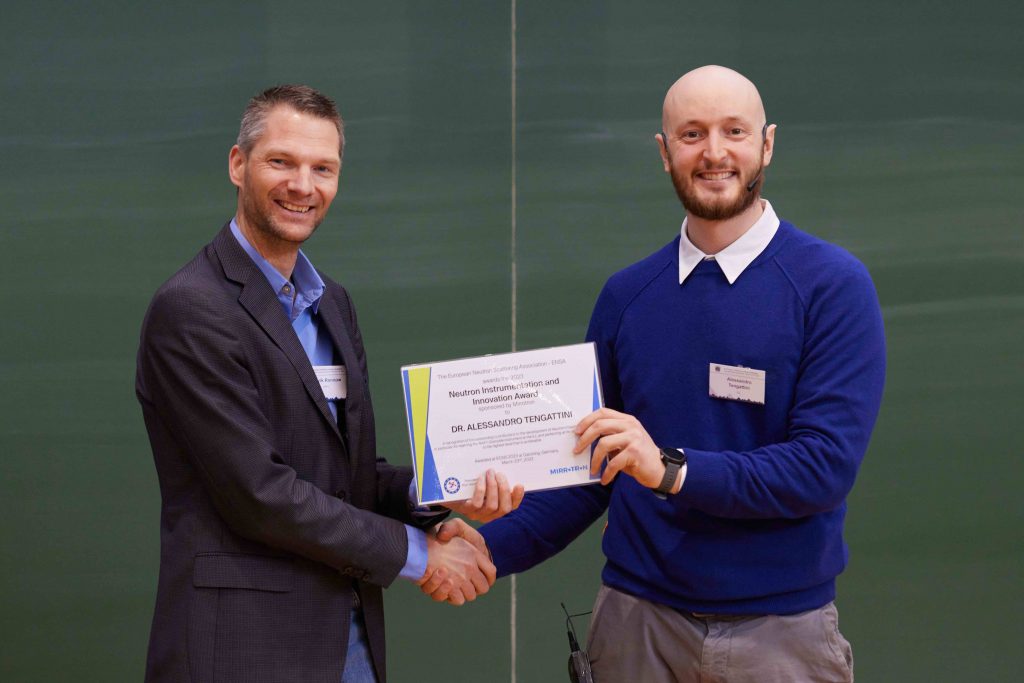
is awarded to dr. Alessandro Tengattini, who currently works as a beam line scientist at the Institut Laue Langevin (ILL) and is an Associate Professor at the Université Grenoble Alpes (UGA), France.
Dr. Alessandro Tengattini is awarded the 2023 ENSA Instrumentation and Innovation Prize for his outstanding contributions to the development of Neutron Imaging. He has realized the NeXT-Grenoble instrument at the ILL starting from a different perspective as X-ray imaging scientist at UGA, and has perfected all capabilities to the highest level that is achievable at the current installation. While other imaging beamlines use large beams for large engineering samples, Alessandro chose to develop NeXT-Grenoble for high resolution in a small beam from the
very start, which has resulted in the world-record in neutron image resolution of 3-4 μm. Among neutron imaging instruments, he was the first to employ 90-degree Heliflex lenses that had originally been developed for medical X-ray intensifiers. In the community, he was one of the first to pioneer with 3D-printed components and NeXTGrenoble now heavily relies on such developments of his own design. For its fast data collection rates, he successfully realized data collection strategies and software derived from the X-ray field.
His achievements were quickly recognized by the ILL Scientific Council, so that NeXT, originally foreseen for engineering experiments of the Université de Grenoble, became part of the official ILL instrument suite with many
exciting new modes of operation that will serve a growing scientific community. All these efforts have brought a new user community to the facility and resulted in many high-quality papers in medicine and biology and other fields.
The ENSA Neutron Instrumentation and Innovation Award is sponsored by Mirrotron.
2021 Prize Winners
1-Walter Hälg Prize Winner: Prof. Peter Böni
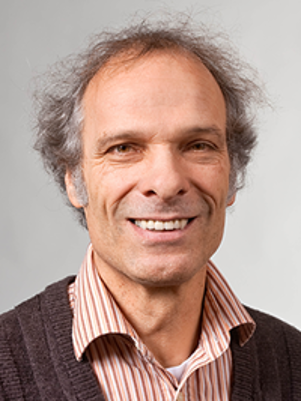
Prof. Böni has been awarded with the Walter Hälg Prize in recognition of his ground-breaking contributions in the fields of superconductivity and magnetism. His most recent work, the discovery of topological skyrmions in MnSi, has established the existence of a new state of matter of topological nature and opened an entirely new field of research with possible applications in information technologies.
In addition, his impressive scientific work is at least mirrored by the impact of his outstanding contributions to the development of novel neutron instruments and instrument components. In particular, his work on innovative neutron optics based on supermirror neutron guides stands out as it is of major importance for the international neutron scattering community. Devices designed by him are essential parts of neutron scattering instruments all over the world. Peter Böni’s work on neutron instrumentation has substantially contributed to the success of at least two major neutron facilities in Europe, notably the FRM II reactor at the Heinz Maier-Leibnitz Zentrum (MLZ) and the Swiss neutron spallation source SINQ at the Paul Scherrer Institute (PSI).
Walter Hälg, was a pioneer of reactor technology and neutron scattering in Switzerland. He was well known to the world-wide neutron scattering community not only through his numerous contributions in instrumentation and science. In 1999 Walter Hälg established the prize, which since 2019 is sponsored by SwissNeutronics AG.
2- Erwin Felix Lewy Bertaut Prize Winner: Dr. Ellen Fogh
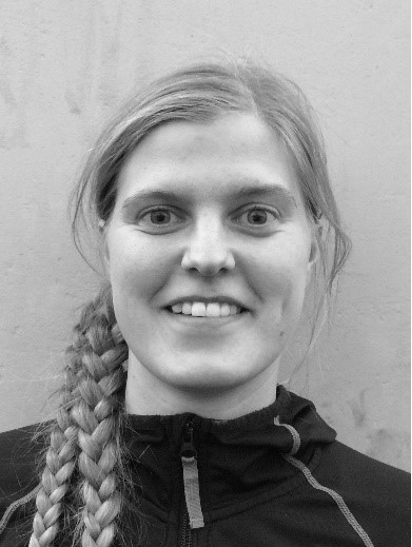
Dr. Ellen Fogh has been awarded with the Erwin Felix Lewy Bertaut Prize in recognition of her multiple early career scientific achievements including her innovative work in the application of the highest available magnetic fields – static and pulsed – to elucidate the complex links between magnetoelectricity and field-dependent magnetic structures.
Among the works she has performed we can cite the multinational effort to study the magnetic structures and excitations of the Shastry-Sutherland antiferromagnet SrCu2(BQ3)2 at dilution fridge temperatures, high pressure (1 GPa) and high field (26T).
Dr. Fogh is a highly talented young researcher who should soon be in a position to lead her own research group. She is a role model for aspiring young women in neutron scattering. She consistently operates at a high scientific level, while managing to carefully mentor younger group members.
The Erwin Felix Lewy Bertaut prize is awarded jointly by the European Neutron Scattering Association (ENSA) and the European Crystallography Association (ECA) in memory of the scientific achievements of Erwin Felix Lewy Bertaut, a pioneer in crystallography and neutron scattering. The prize is sponsored by Mirrotron.
3- Neutron Instrumentation and Innovation Award Winner: Dr. Mads Bertelsen
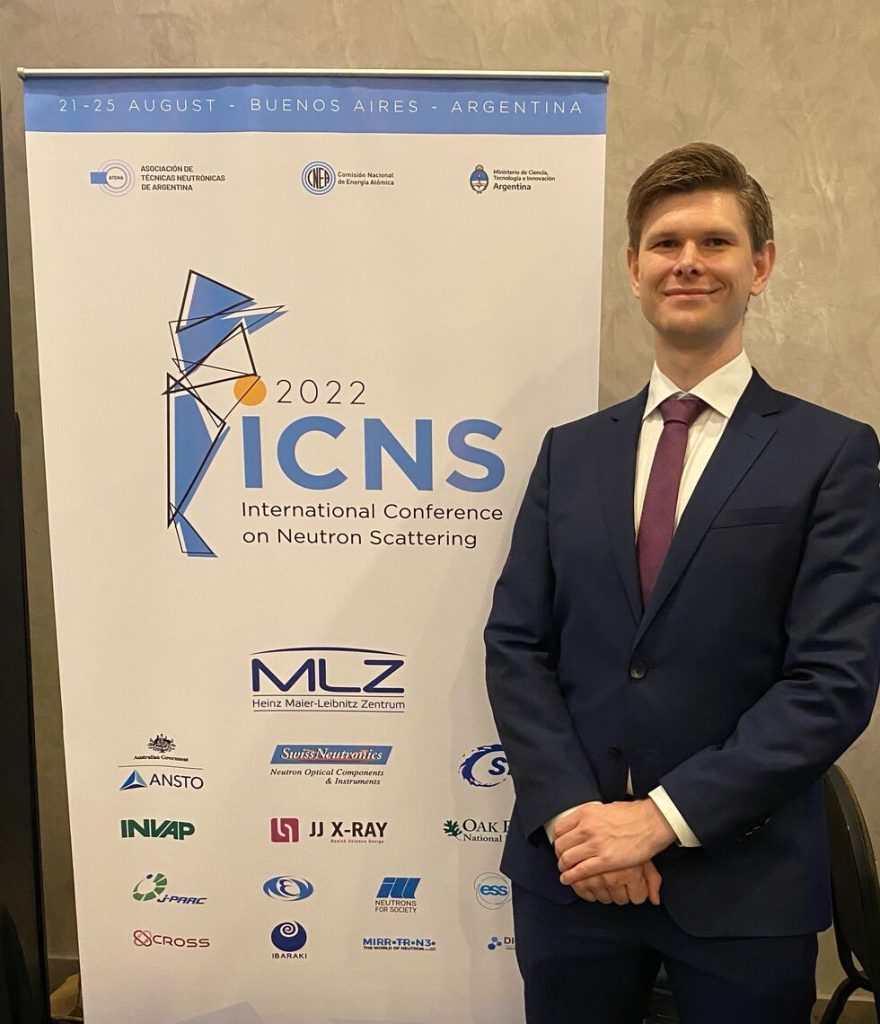
In his young career, Dr. Bertelsen has already demonstrated remarkable contributions to neutron instrumentation. He has been awarded the 2021 Neutron Instrumentation and Innovation award in recognition of his innovative extensions of the Monte Carlo ray-tracing simulation software McStas, Guide_bot and Union.
His software Guide_bot, has simplified the process of adequately optimizing guides, which previously was tedious and time-consuming, and, in practice, impossible to do comprehensively.
Union, makes it possible for a user to simulate with McStas virtually any arbitrarily shaped component of an instrument or experimental setup. Hence, simulations can now be made at a level of detail which previously were considered impossible.
Both extensions have had a significant impact on the design of instrumentation and experiments, and hence the scientific impact from neutron scattering. His contribution has been pivotal for the design of the ESS instrument suite.
Neutron science relies on state-of-the-art infrastructure and therefore crucially on the numerous colleagues who invent, implement and maintain instrumentation and techniques. The Neutron Instrumentation and Innovation Award (NI&I) award was created by ENSA to recognize individuals who devote part of their career to enable science on a much broader scale than can be achieved by each researcher alone. The NI&I award is sponsored by Mirrotron.
Call for Nominations 2021 for 3 Prizes:
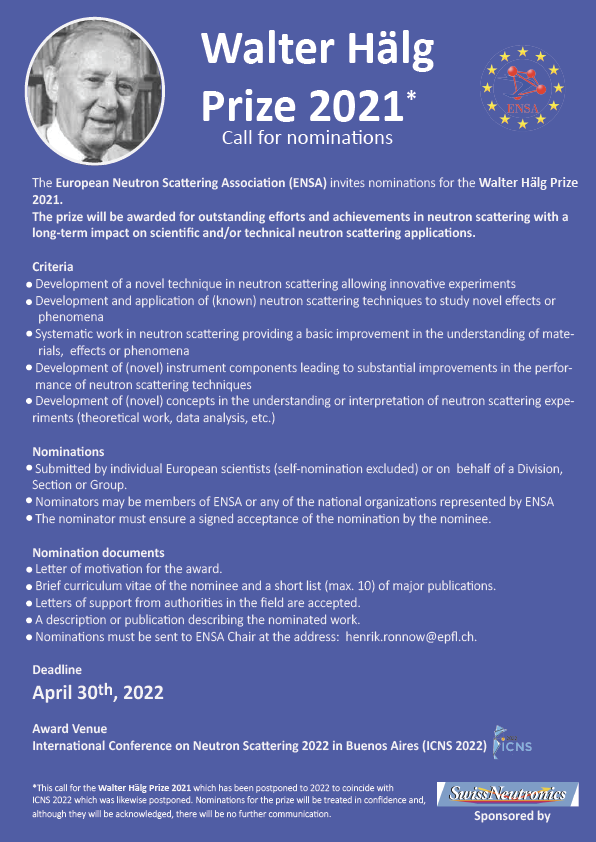
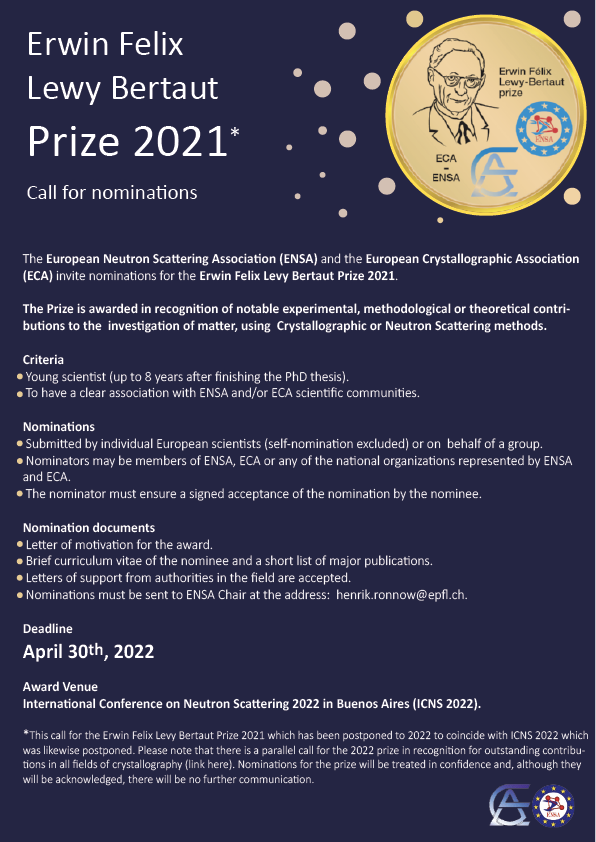
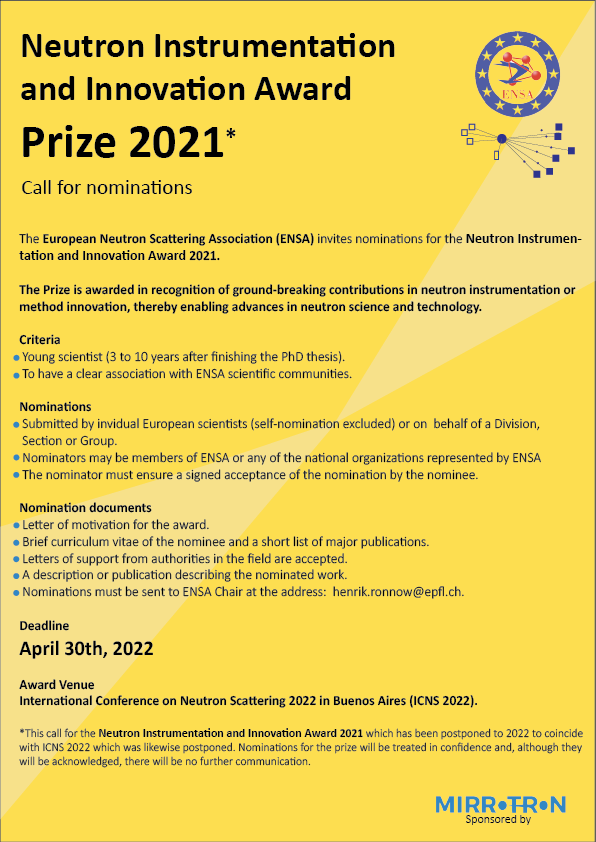
Awards of 2019
In 2019 ENSA awarded 2 prizes on a biennal basis: The Walter Hälg Prize since 1999 and, for the first time this year: the Neutron Instrumentation and Innovation Prize.
Walter Hälg Prize
The 2019 Walter Hälg Prize sponsored by SwissNeutronics.
The Walter Hälg Prize was first made available to the European Neutron Scattering Association (ENSA) by a donation from the late Professor Walter Hälg who was the founder of neutron scattering in Switzerland. His wife Madeleine Hälg-Degen continued to sponsor the highly prestigious ENSA prize in his name. After the exhaustion of the Hälg donation, the company SwissNeutronics AG recently agreed to continue the sponsorship of the highly prestigious ENSA prize starting in the year 2019.
The Prize is awarded biennially to a European scientist for outstanding, coherent work in neutron scattering with long-term impact on scientific and/or technical neutron scattering applications. The previous winners were F. Mezei (1999), J. Brown (2001), R.A Cowley (2003), A. Furrer and H. U. Güdel (2005), J. Penfold (2007), D. Richter (2009), G. Lander (2011), J. Zaccai (2013), H. Rauch (2015) and J. Colmenero (2017). The eleventh award of the Prize (10’000 CHF) is to be made at a special ceremony at the European Conference on Neutron Scattering (ECNS 2019), the 1st to 5th July in Saint Petersbourg in Russia. The detailed guide-lines of the Walter Hälg Prize are listed below.
Selection Committee
Nominations for the prize will be considered by a Selection Committee, which consists of authorities representing major scientific disciplines. It includes acknowledged experts both in neutron scattering and from outside the neutron scattering community. Membership in the Selection Committee is obtained by invitation extended by the ENSA Committee.
Call for Nominations
European scientists as individuals or on behalf of a Division, Section or Group may submit nominations for the 2019 Walter Hälg Prize of the European Neutron Scattering Association (ENSA). To establish a high standard it is necessary that the Committee receive proposals, which represent the breadth and strength of European neutron scattering. Nominations should include the motivation for the award, brief curriculum vitae of the nominee and a short list of major publications.
Maximum 5 letters of support from authorities in the field, which outline the importance of the work, would also be helpful. Nominations for the Prize will be treated in confidence and although they will be acknowledged there will be no further communication. Previous nominations have to be up-dated and resubmitted.
Deadline
Nominations should be sent before 31 May 2019 to the President of the Selection Committee, preferably by electronic mail in pdf format to:

Professor Christiane Alba-Simionesco
chair of ENSA
Director of the Laboratoire Léon Brillouin (LLB) in Saclay 91191 Gif-sur-Yvette cedex France
Email: christiane.alba-simionesco@cea.fr
About the Walter Hälg Prize
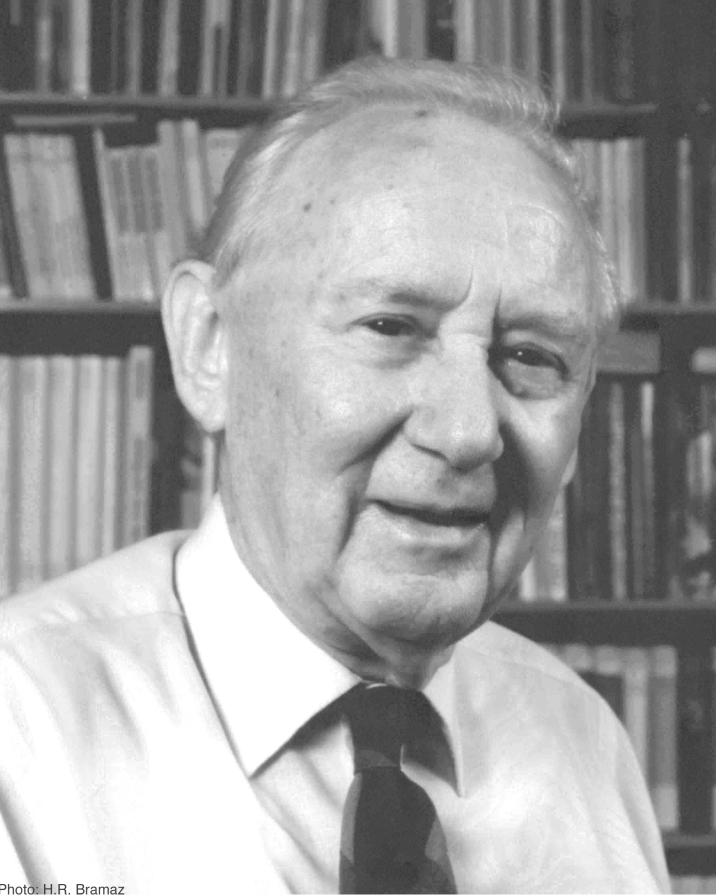
Walter Hälg, the pioneer of reactor technology and neutron scattering in Switzerland, passed away peacefully on December 28, 2011 at the age of 94. He was well known to the world wide neutron scattering community not only through his numerous contributions in instrumentation and science, but also by his generous sponsorship of the Walter Hälg Prize which has been awarded biennially to distinguished scientists by the European Neutron Scattering Association (ENSA) since 1999.
Born in Basel in 1917, citizen of Basel, Switzerland, he was one of the pioneers in the area of neutron science. Experimental physics, theoretical physics, chemistry, and mathematics were the four fields that took up his student time at the Basel University where in 1943 he received his PhD in molecular physics. From 1943 to 1946 he worked in particle physics at the Physical Institute of the University of Basel and on the construction of a 1 MeV Cockroft-Walton accelerator in Basel. He spent the years 1946-1960 at the Brown Boveri Company (BBC, predecessor of the current ABB) in Baden, Switzerland, and was promoted head of the physics department in 1953. During his time at BBC, he worked on the development of the Swiss heavy water reactor DIORIT at Würenlingen, which went critical on 26 August 1960. In between, i.e. 1952/1953, he was sent to the Dutch-Norwegian Reactor Research Institute JENER in Kjeller, Norway.
In 1960, he was named full Professor and director at the newly founded “Institut für Reaktortechnik IRT” at ETH Zürich, with an outstation at the EIR Würenlingen. His main fields of research focused on reactor theory, numerical mathematics, neutron diffraction, and computer science. He was involved in the construction of the neutron spectrometers at the reactor DIORIT as well as in the development of a multiprocessor computer (16 CPU’s) for solving partial differential equations. After decommissioning of the reactor DIORIT in August 1974, he carried out the first calculations for a spallation source using the surplus protons of the 590 MeV ring of the near SIN institute for neutron production, seeing the limitations for neutron scattering at the reactor SAPHIR in Würenlingen, ideas supported also by Walter E. Fischer.
Professor Hälg’s contributions to neutron scattering are extensive. He supervised many PhD students in neutron scattering, among them the A. Furrer, P. Fischer, and J. Schefer. For 10 years, he was a member and president of the Research Board of the ETH Zürich until his retirement in autumn 1984 when he became an honorary member of the executive board of the Swiss Neutron Scattering Society. He was also honorary member of the distinguished Physical Society of Zürich.
Albert Furrer continued Walter Hälg´s work as the new head of the Laboratory for Neutron Scattering. In 1996, the neutron scattering activities were moved from the reactor SAPHIR to the newly built continuous spallation neutron source SINQ at the Paul Scherrer Institute, a merger between SIN and EIR.
Albert Furrer was acting chairman of the European Neutron Scattering Association when he proposed Professor Hälg to sponsor and to give his name to the Prize. The award is given to European scientists who have achieved an outstanding research program in neutron scattering with a long-term impact on scientific and /or technical neutron scattering applications. The scope of this prize is coincident with the result of the professional career of the man who gave his name to this prize. Walter Hälg will be remembered by many in the field not only as a pioneer in reactor technology and neutron scattering but also as a friend. His wife Madeleine Hälg-Degen continued to sponsor the highly prestigious ENSA Prize until her death in 2017. In the future it will be called the Walter and Madeleine Hälg Prize. We are pleased that SwissNeutronics AG, Klingnau, Switzerland, kindly agreed to take over the sponsorship.
The original GUIDE LINES for the Walter Hälg Prize.
Neutron Instrumentation and Innovation Prize
The inaugural 2019 Neutron Instrumentation and Innovation Award sponsored by Mirrotron.
The European Neutron Scattering Association hereby announce the inauguration of a new prize, the Neutron Instrumentation and Innovation Award. The prize will be awarded to an early career scientist or engineer in recognition of ground-breaking contributions in neutron instrumentation or method innovation, thereby enabling advances in neutron science and technology. This includes realization of new neutron instruments, pioneering of neutron science in new fields of applications, invention of new neutron techniques or development of new analysis methods and software, as well as other major contributions enabling advancement of neutron science. Early career typically means 3-10 years after a PhD, but both younger and more senior candidates may be considered. The prize amount (2072 CHF) is generously sponsored by the company Mirrotron, a leading manufacturer of neutron instrumentation components. The Prize will awarded biennially (synchronized with the European or international Neutron Scattering Conferences).
The inaugural award of the Neutron Instrumentation and Innovation Award will be made at a special ceremony at the European Conference on Neutron Scattering (ECNS 2019), the 1st to 5th July in Saint Petersburg in Russia.
Call for Nominations
European scientists as individuals or on behalf of a Division, Section or Group may submit nominations for the 2019 Neutron Instrumentation and Innovation Award of the European Neutron Scattering Association (ENSA). Nominations should include a nomination letter motivating the award, a brief curriculum vitae of the candidate, a description or publication describing the nominated work. Letters of support may be included. Nominations for the Prize will be treated in confidence and although they will be acknowledged, there will be no further communication.
Deadline
Nominations should be sent before 31st of May 2019 to the President of the Selection Committee, preferably by electronic mail in pdf format:
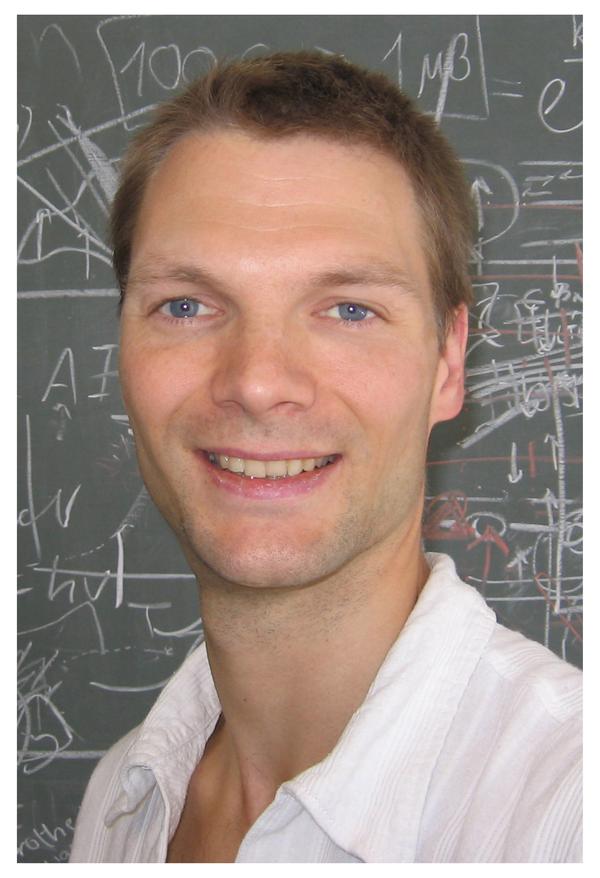
Professor Henrik M. Rønnow
Laboratory for Quantum Magnetism (LQM)
Ecole Polytechnique Federale de Lausanne (EPFL)
1015 Lausanne, Switzerland
Email: henrik.ronnow@epfl.ch
The GUIDE LINES for the Neutron Instrumentation and Innovation Prize.
